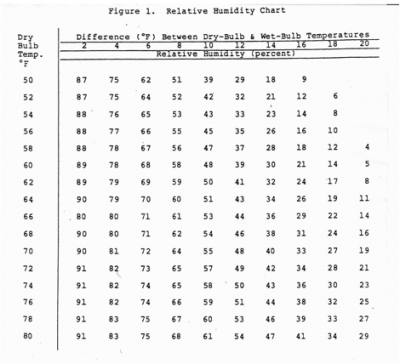The spring and fall are times when humidity related diseases usually peak in the greenhouse. Sunny days increase the transpiration of moisture from leaf surfaces and evaporation from soil surfaces. The warm air holds the moisture in vapor form. At night as the air cools to the dewpoint, condensation occurs and water droplets are formed on cooler surfaces such as the leaves and glazing. This moisture promotes the germination of fungal pathogen spores such as Botrytis or the powdery mildews.
There are several ways to reduce the humidity level.
Vent the humid air – One of the most effective ways is to exhaust the moist air and replace it with cooler, dryer, outside air. The temperature of the air greatly affects its capacity to hold water vapor. Air at 70 deg. F will hold twice as much moisture as air at 50 deg. F. In the range of temperatures encountered in a greenhouse, for every 20 deg F rise in dry bulb temperature, the water-holding capacity of the air doubles and the relative humidity is reduced by one-half.
Applying this principle to the problem of reducing humidity, we see that by exhausting the humid air in the greenhouse and replacing it with cool, dry outside air which when warmed will absorb more moisture, we can lower the humidity.
In glass houses with vents, the heat should be turned on and the vents opened. In houses with fans, the fans should be activated and operated for a few minutes and then the heater turned on to bring the air temperature up if needed.
What does it cost? Based on 1000 sq ft of greenhouse floor area (approximately 10,000 cu ft of air) it would take 4,000 Btu of heat to raise the temperature of the new air 20 deg. F. At $3.00/gallon of fuel oil or $2.00/gallon of propane and 75% heater efficiency, cost is about $0.11/cycle. With $1.10/ccf natural gas the cost is only $0.05. Usually this is done about two or three times/hour during the evening after the sun goes down and early in the morning at sunrise.
Although some growers leave vents cracked open all night, it is more energy efficient to control the cycling with a time clock or humidistat. With a fan system, a relay may be needed to lock out the furnace or boiler until the fan shuts off so that flue gases are not drawn into the greenhouse.
Anti-drip Plastic – On poly covered greenhouses, the use of a wetting agent either sprayed on the interior surface or as part of the formulation of the glazing can help reduce the humidity level. The moisture that condenses on the glazing will drain to the eave or foundation rather than forming droplets and dripping onto the plants.
Glass greenhouses with a normal roof pitch (6:12) will allow moisture to run off without a wetting agent. More condensation will occur on single glazing than with double as the dewpoint is reach sooner.
Air Movement – In a dense canopy of foliage the relative humidity can be 20% – 40% higher than the air above it do to stratification. Continuous air circulation helps to reduce this stratification. This keeps the leaf temperature higher.
If the greenhouse is heated with hot air furnaces, continuous air movement can be obtained by running the blowers continuously.
A fan-jet system in which air is forced through a perforated tube mounted below the ridge will circulate the air. The fan is set to run continuously and either draws in outside air through a louver or recirculates air with the greenhouse.
The horizontal air flow (HAF) system gives good circulation and mixing with small fans (1/15 horsepower, 12” to 20” diameter). Fans on one side of the greenhouse force air in one direction and on the other side, in the other direction. Fans are run continuously except when the exhaust fans are on.
Reduce Evaporation Potential – Besides transpiration, considerable moisture comes from evaporation from wet surfaces. Evaporation can be controlled by keeping floor surfaces dry and by using drip irrigation that only wets the soil surface rather than overhead irrigation that wets the foliage.
Control – Humidity is usually controlled by a humidistat. These use human hair, polystyrene, nylon or cellulose acetate butyrate as a sensor. Accuracy depends on good maintenance of the sensor.
If you study a psychrometric chart, you will see that slight changes in temperature result in large changes in relative humidity. The ratio of inside temperature to outside temperature also influences moisture levels. For these reasons, vapor pressure deficit (the difference between saturation and actual vapor pressure) gives a better measure of humidity level. Some greenhouse computer systems are set up to control humidity based on VPD rather than relative humidity.
Moisture control is important to get good plant growth without excessive disease pressure. Simple methods can be used to give this control.
John W. Bartok, Jr., Extension Professor Emeritus & Agricultural Engineer, Department of Natural Resources and the Environment, University of Connecticut, Storrs CT – Updated 2013.
